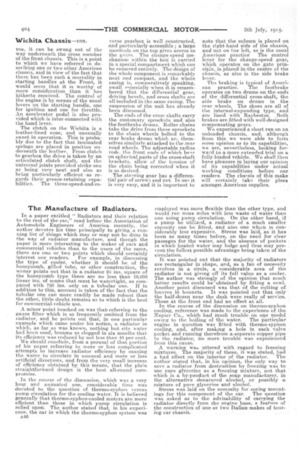The Manufacture of Radiators.
Page 18

If you've noticed an error in this article please click here to report it so we can fix it.
In a paper entitled " Radiators and their relation to the rest of the car," read before the Association of Automobile Engineers of America recently, the author devotes his time principally to giving a running list of things which may or may not be done in the way of radiator manufacture, and though the paper is more interesting to the maker of cars and commercial vehicles than to the users of the same, there are one or two points which should certainly
interest our readers. For example, in discussing the type of cooler, whether it should be of the honeycomb, gilled tube, or other construction, the writer points out that in a radiator 24 ins, square of the honeycomb type there are no less than 10,000 linear ins, of seams that must be watertight, as cornpared with 750 ins, only. on a tubular one. If in addition to this, account is taken of the fact that the tubular one can more readily be made robust than the other, little doubt remains as to which is the best for commercial-vehicle use.
A minor point touched on was that, referring to the gauze filter which is so frequently omitted from the radiator, and he points out that, in one particular example which came under his notice, a radiator in which, as far as Was known, nothing but city water had been used, became so clogged in six months that its efficiency was reduced by not less than 40 per cent.
We should conclude, from a perusal of that portion of his paper referring to more or less complicated attempts to increase radiator efficiency by causing the water to circulate in unusual and more or less artificial directions, and from the very small increase of efficiency obtained by this means, that the plain straightforward design is the best all-round compromise.
In the course of the discussion, which was a very long and animated one, considerable time was devoted to the question of thermo-syphon versus pump circulation for the cooling water. It is believed generally that thermo-syphon-cooled motors are more efficient than those in which pump circulation is relied upon. The author stated that, in his experience, the car in which the thermo-syphon system was a46
employed was more flexible than the other type, and would run more miles with less waate of water than one using pump circulation. On the other hand, if a pump -be utilized, a radiator of a much mailer capacity can be fitted, and also one which is considerably less expensive. Stress was laid, as it has been so many times before, on the need for clear passages for the water, and the absence of pockets in which heated water may lodge and thus may prevent the fullest possible advantage being taken of the circulation.
It was pointed out that the majority of radiators are rectangular in shape, and,. as a fan of necessity revolves in a circle, a considerable area of the radiator is not giving off its full value as a cooler. The author was strongly of the opinion that much better results could be" obtained by fitting a cowl. Another point discussed was that of the cutting of louvres in -bonnets. It was pointed out that only the half-dozen near the dash were really of service. Those at the front end had no effect at all.
In the course of the discussion on thermo-syphon cooling, reference was made to the experience of the Napier Co., which had much trouble on one model owing to the boiling of the water. The particular engine in question was 'fitted with thermo-syphon cooling, and, after making a hole in each valve pocket and running therefrom a:separate copper pipe to the radiator, no more trouble was experienced from this cause.
A warning waa uttered with regard to freezing mixtures. The majority of these, it was stated, had a bad effect on the interior of the radiator. The author stated that, in his opinion, the only way to save a radiator from destruction by freezing was to use pure glycerine as a freezing mixture, not that which is a by-product of the soap manufacturer, in the alternative denatured alcohol, or possibly a mixture of pure glycerine and alcohol. Stress was laid on the necessity for spring mountings for this component of the car. The question was asked as to the advisability of carrying the radiator directly frem the engine base, a feature of the construction of one or two Italian makes of touring car chassis.






















